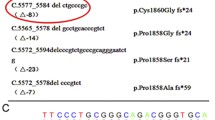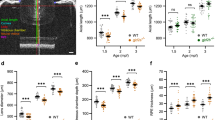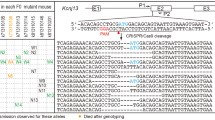Abstract
Using a positional cloning approach supported by comparative genomics, we have identified a previously unreported gene, EYS, at the RP25 locus on chromosome 6q12 commonly mutated in autosomal recessive retinitis pigmentosa. Spanning over 2 Mb, this is the largest eye-specific gene identified so far. EYS is independently disrupted in four other mammalian lineages, including that of rodents, but is well conserved from Drosophila to man and is likely to have a role in the modeling of retinal architecture.


Similar content being viewed by others
References
Ruiz, A., Borrego, S., Marcos, I. & Antinolo, G. Am. J. Hum. Genet. 62, 1452–1459 (1998).
Khaliq, S. et al. Am. J. Hum. Genet. 65, 571–574 (1999).
Barragán, I., Marcos, I., Borrego, S. & Antiñolo, G. Ophthalmic Res. 37, 89–93 (2005).
Abd El-Aziz, M.M. et al. Ann. Hum. Genet. 71, 281–299 (2007).
den Hollander, A.I. et al. Nat. Genet. 39, 889–895 (2007).
Abd El-Aziz, M.M. et al. Ann. Hum. Genet. 72, 463–477 (2008); published online 29 May 2008.
Barragan, I. et al. Ann. Hum. Genet. 72, 454–462 (2008); published online 29 May 2008.
Holbrook, J.A., Neu-Yilik, G., Hentze, M.W. & Kulozik, A.E. Nat. Genet. 36, 801–808 (2004).
Husain, N. et al. Dev. Cell 11, 483–493 (2006).
Zelhof, A.C., Hardy, R.W., Becker, A. & Zuker, C.S. Nature 443, 696–699 (2006).
Murphy, W.J., Pringle, T.H., Crider, T.A., Springer, M.S. & Miller, W. Genome Res. 17, 413–421 (2007).
Huchon, D. et al. Mol. Biol. Evol. 19, 1053–1065 (2002).
Huang, H. et al. Genome Biol. 5, R47 (2004).
Acknowledgements
We would like to thank the families who participated in the study. This study was funded by Fondo de Investigación Sanitaria (PI050857), Spain; Consejería de Salud (PI-0334/2007), Junta de Andalucía, Spain; British Retinitis Pigmentosa Society (grant ref. GR556); Foresight, Dubai; Foundation Fighting Blindness (USA); National Institute of Health Research Biomedical Research Centre for Ophthalmology, The Special Trustees of Moorfields Eye Hospital London; the UK Medical Research Council and EU-Neurotrain (grant ref. MEST-CT-2005-020235); EU-GENORET (grant ref. LSHG-CT-2005-512036). The El Centro de Investigación Biomédica en Red de Enfermedades Raras is an initiative of the Instituto de Salud Carlos III. N.P.C. and E.P. were supported by the Wellcome Trust. We would like also to thank R. Molday (University of British Columbia, Vancouver) for the gift of 1D4 antibody and G. Jeffery for his advice with immunohistochemistry.
Author information
Authors and Affiliations
Contributions
S.S.B. and G.A. designed the study; M.M.A., I.B., C.A.O., J.I.P., M.F.E. and L.A.S. performed the mutation screening; I.B., M.M. and S.B. performed the MLPA experiments; C.A.O., A.S., C.C. and M.E.C. performed the immunohistochemistry; L.G. and C.P.P. carried out the bioinformatics analysis and the evolutionary work; E.P. and N.P.C. carried out the array-CGH analysis; M.M.A. and S.S.B. were mainly responsible for the writing of the manuscript and prepared the tables, figures and supplementary material, with input from all coauthors.
Corresponding authors
Supplementary information
Supplementary Text and Figures
Supplementary Methods, Supplementary Note, Supplementary Figures 1–4, Supplementary Table 1 (PDF 2022 kb)
Rights and permissions
About this article
Cite this article
Abd El-Aziz, M., Barragan, I., O'Driscoll, C. et al. EYS, encoding an ortholog of Drosophila spacemaker, is mutated in autosomal recessive retinitis pigmentosa. Nat Genet 40, 1285–1287 (2008). https://doi.org/10.1038/ng.241
Received:
Accepted:
Published:
Issue Date:
DOI: https://doi.org/10.1038/ng.241
- Springer Nature America, Inc.
This article is cited by
-
Investigating the associations of macular edema in retinitis pigmentosa
Scientific Reports (2023)
-
The medaka mutant deficient in eyes shut homolog exhibits opsin transport defects and enhanced autophagy in retinal photoreceptors
Cell and Tissue Research (2023)
-
Ocular biometry with swept-source optical coherence tomography-based optical biometer in Japanese patients with EYS-related retinitis pigmentosa: a retrospective study
BMC Ophthalmology (2022)
-
Evaluation of photoreceptor-directed fibroblasts derived from retinitis pigmentosa patients with defects in the EYS gene: a possible cost-effective cellular model for mechanism-oriented drug
Stem Cell Research & Therapy (2022)
-
Genotypic and phenotypic profiles of EYS gene-related retinitis pigmentosa: a retrospective study
Scientific Reports (2022)





